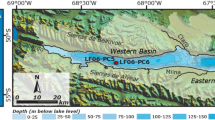Abstract
The distribution for percent content of light mineral is divided in detail to emphasize distributional trends of higher and lower contents by using 222 samples of light mineral in the southern Yellow Sea. 5 mineral provinces are divided, and they are I -north mineral province of the southern Yellow Sea, the sediment dominantly derived from the Yellow River; II-mixed mineral province, the sediment derived from both the Yellow River and Yangtze River; Illmiddle mineral province, the sediment derived mainly from the Yellow River and a part of sediment derived from Yangtze River; IV-province east of Yangtze River mouth, the sediment derived dominantly from Yangtze River; and V-south mineral province, sediment was affected by relict sediment and modern sediment of Yangtze River. In this paper, the assemblage of dominant mineral and diagnostic mineral for the five provinces are discerned.
Similar content being viewed by others
References
Schafer, J., Wolfgang, D., Heavy-mineral analysis and typology of detritus zircon: A new approach to provenance study, Journal of Sediment Research, 1997, 67(3): 451–461.
Uddin, A., Lundberg, N., Unroofing history of the eastern Himalaya: heavy-mineral study of Cenozoic sediments from the Bengal Basin, Bangladesh, Journal of Sediment Research, 1998, 68(3): 465–472.
Vital, H., Stattegger, K., Garbe-Schonberg, C., Composition and trace-element geochemistry of detrital clay and heavy-mineral suits of the lowermost Amazon River: A provenance study, Journal of Sediment Research, 1999, 69(3): 563–575.
Jeffry, D. G., Detrital magnetite as a provenance indicator, Journal of Sedimentary Petrology, 1990, 60(6): 940–951.
Stephanie, J. S., Detrital opaque oxides as provenance indicators in River Nile sediment, Journal of Sediment Research, 1995, 65(4): 668–674.
Graham, I. J., Glasby, G. P., Churchman, G. J., Provenance of the detrital component of deep-sea sediments from the Sw Pacific ocean based on mineralogy, geochemistry and Sr isotopic composition, Marine Geology, 1997, 140: 75–96.
Liou, M. H., Wu, S. Y., Wang, Y. J., Late Quaternary Period Sedimentation of Yellow Sea (in Chinese), Beijing: China Ocean Press, 1987, 69–71.
Qin, Y. S., Zhao, Y. Y., Chen, L. R. et al., Geology of the Yellow Sea (in Chinese), Beijing: Ocean Press, 1989, 100–102.
Chen, L. R., Study on the mineral assemblage of the Bohai Sea, Yellow Sea and East China Sea, Marine Sciences (in Chinese), 1989, 2: 1–7.
Chen, L. R., Xu, W. Q., Shen, S. X., A study on the light mineral in the sediments of the East China Sea, Studia Marina Sinica (in Chinese), 1984, (21): 297–304.
Zhao, Y. Y., Yan, M. C., Geochemistry of Sediments of the Chinese Shallow Sea (in Chinese), Beijing: Science Press, 1994, 1–17.
Yang, Y. H., Cao, X. Y., Liou, S. H. et al., Mathematic Methods of Geology (in Chinese), Shenyang: Eastnorth China Normal University Press, 1992, 1–24, 71–174.
Lu, W. D., Zhu, Y.L., Sha, J. et al., SPSS for Windows from Rudiment to Proficiency (in Chinese), Beijing: Publishing House of Electronics Industry, 1997.
Author information
Authors and Affiliations
Corresponding author
About this article
Cite this article
Wang, K., Shi, X. & Jiang, X. Sediment provenance and province of the southern Yellow Sea: Evidence from light mineral. Chin.Sci.Bull. 48 (Suppl 1), 30–36 (2003). https://doi.org/10.1007/BF02900937
Received:
Issue Date:
DOI: https://doi.org/10.1007/BF02900937




